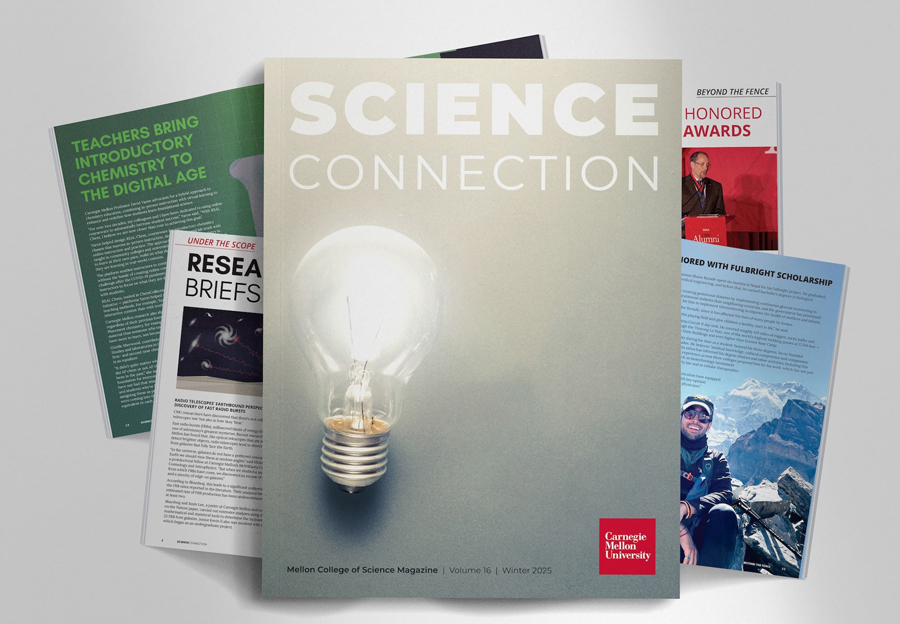After 42 Years, Fred Lanni Changes Focus
By Kirsten Heuring
Media Inquiries- Interim Director of Communications
Examining cells with a microscope has always been a big deal for Associate Professor of Biological Sciences Frederick Lanni, proving that sometimes the smallest things can have the greatest impact.
Lanni arrived at Carnegie Mellon as a postdoctoral researcher in August of 1982 to work with Professor D. Lansing Taylor. Taylor, along with the late Professor Alan Waggoner and Emeritus Professor Robert F. Murphy, had created the Center for Fluorescence Research in Biomedical Sciences, and Lanni wanted to be part of it.
"The original goal was to bring modern methods of imaging, fluorescence technology, and computer analysis into cell biology where problems in that field could really be addressed," Lanni said. "Lans Taylor liked to say that a cell was 'a living cuvette.' We spent a great deal of time utilizing the work of many, many talented people developing machine-vision microscopes, synthesizing fluorescent probes and creating computer programs to do timelapse imaging of living cells on the microscope."
One of the steps for enhancing cellular imaging was to improve the tools being used to examine cells. When the Fluorescence Center was founded, fluorescence microscopy involved using night vision camcorders to take video of the cells. Then, researchers would photograph the videotape playback and develop and print the film based on what they were attempting to examine.
Lanni and his colleagues wanted a better way to see the structures within a cell, so they developed what they called standing wave fluorescence microscopy (SWFM), an early version of what is now better known as structured illumination microscopy (SIM). This technique allowed researchers to see the 3D structure of cells by fluorescence at a higher resolution than they could before.
"It was a way to use the interference of light to improve the three-dimensional resolution of the fluorescence microscope," Lanni said. "The standing wave microscope was the first working instrument to use this principle."
Lanni's personal scientific goal has been to understand living cells better biophysically. At the time, scientists did not know whether the cytoplasm in a cell was a solid, a liquid or a gel. In 1987, Lanni, Taylor and their colleagues Kate Luby-Phelps, who was a postdoctoral fellow with Taylor, and Phil Castle, who graduated with a bachelor of science in biological sciences in 1986, answered this question by using the microscope to measure the diffusion of different-sized carbohydrate molecules within living cells.
"We showed that the cytoplasm behaves like a dynamic gel network. In other words, in the cytoplasm, there was a meshwork that restricted the motion of larger particles," Lanni said. "This was the first experimental demonstration of an idea that had long been suspected."
In recent years, Lanni's research has pivoted to investigating Candida albicans, a common human fungal pathogen. This work has been a 14-year collaboration with molecular geneticist Aaron Mitchell, distinguished professor of microbiology at University of Georgia, and who graduated in 1977 with an undergraduate degree in biological sciences from Carnegie Mellon. Though C. albicans is typically harmless, it can be infectious under some circumstances and very dangerous if it enters the bloodstream of an immunosuppressed person. Under stress, it sprouts long filaments known as hyphae and grows as a dense, entangled biofilm or adherent surface colony.
C. albicans can be extremely difficult to image, Lanni said, because of the thickness and opacity of its colonies. Lanni found a way to render the biofilms transparent for fluorescence microscopy. With Mitchell, he is looking for ways to suppress the invasive growth of hyphae.
Lanni has taught generations of Carnegie Mellon students, mostly in Modern Biology, the introductory course for students in the Department of Biological Sciences, and a popular science elective for others. He also developed and taught Biological Imaging and Fluorescence Spectroscopy, a course for graduate students and upper-level undergraduates. There, he shared his passion for microscopy with students who needed a research-level understanding of the instrument.
"It was a really fun course to teach," Lanni said. "It was the course that was closest to my heart."
Lanni retired at the end of the fall 2024 semester. He plans to conduct research as an emeritus professor, and he hopes to spend more time with his adult children, who live across the U.S. He said he is proud of the discoveries he has made as a researcher.
"The greatest thing about science is, every once in a while, you realize that you're looking at a result that no one else has ever seen before or gotten before," Lanni said. "I'm so glad I've had those moments."
